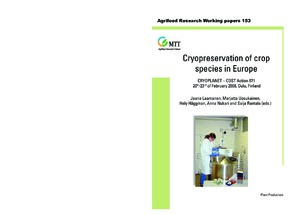In vitro methods used in preservation of fruit germplasm in Serbia
Ruzic, Djurdjina; Vujovic, T; Cerovic, R (2008)
Ruzic, Djurdjina
Vujovic, T
Cerovic, R
Julkaisusarja
Agrifood Research Working papersMTT:n selvityksiä
Numero
153
Sivut
s. 57-58
MTT
2008
Tiivistelmä
the Fruit Research Institute which is situated in Èaèak (Serbia), there is a significant collection (1,136 cultivars) of different fruit species. Our research, among other things, involves clonal selection of autohtonous plum and sour cherry cultivars (Prunus domestica L. and Prunus cerasus L.) and some apples (Malus domestica Borkh.) with good storage capacity. Our breeders are interested in many local varieties with some good characteristics, i.e. resistance to pest and diseases, long shelf life etc, and also in prevention of their extinction. From these reasons many years ago we included some in vitro methods to establish in vitro germplasm collection, as a possibility of storing germplasm for medium-term conservation, for germplasm exchange, as well as for the possibility of its rapid propagation when necessary. We used cold storage technique in the simple conditions, i.e. at +5oC in the total darkness. Before transfering the cultures into cold chamber we subcultured the plants for 7, 14 and 21 days to find the best duration time of precondition subculture. After cold storage we kept these cultures for 3 days in growth room for adaptation and after that the parameters of multiplication were measured, and also after 1 month. In that way plum cv Po egaèa was successfully stored up to 10 months with very good multiplication index and regrowth (1). Cherry rootstocks Gisela 5 and Tabel Edabriz were also successfully stored for 3 months in the same conditions with 100% survival rate and good regrowth, i.e. the multiplication index increased after that by 1.8 and 4.8, respectively. The measured quantity of N taken from medium during cold storage was lower than in standard conditions (2). As in vitro storage of the germplasm of small fruit could be easily achieved, the loss of the material being only accidental, 3-month maintenance of raspberry cv Meeker in our lab under cold temperature conditions has proved to be beneficial, accompanied by high viability rate (exceeding 67%). Similar results were also obtained for other raspberry cultivars (3). Thus, multiplication index and shoot length of raspberry cv Meeker were increased by 1.2 and 1.5 times respectively in the first subculture upon cold storage. The nitrogen uptake of plants in cold storage was also very low, i.e. 32.9% of N was absorbed as compared to the initial nitrogen quantity in the medium. Low uptake of N from the medium shows that this element does not have to be added to the medium during storage under chilling conditions, i.e. slow growth is accompained by slow uptake of this constituent from the medium (4). However, our results showed that the shoots of these species could be stored under very simple conditions with normal growth and enhanced multiplication after conservation, thus providing the conditions for the development of standard protocol for maintenance in in vitro germplasm. Last year we started with encapsulation of shoot tips of blackberry cv Èaèanska bestrna and raspberry cv Meeker in calcium alginate, i.e. preservation in alginate beads at 5oC in the darkness. Sodium alginate was dissolved in water with 4% glucose, or 3% sucrose, and in MS medium (5) without growth regulators with 4% glucose or 3% sucrose (6). Regrowth ability of the stored explants and in vitro multiplication in three successive subcultures were evaluated. In cv Èaèanska bestrna 18.8% survived encapsulation after 1 month and gave regrowth, while in cv Meeker 6.3% survived encapsulation after 1 month and gave regrowth, and 18.8% after 2 months. We did not obtain viable explants after three months of encapsulation in both genotypes. Regrowth was only determined in both genotypes in alginate beads with MS and 3% sucrose. Multiplication index decreased from the first to the third subculture in blackberry. However, it slightly increased in raspberry towards the third subculture. These results are a small step towards developing a new storage protocol technique for fruits in general and its introduction in our country, leading to cryopreservation technique.
Collections
- Julkaisut [87088]
